University Corporate Governance Case Study: Lotsa Subs Ltd Analysis
VerifiedAdded on 2021/04/17
|17
|4338
|263
Case Study
AI Summary
This case study analyzes the corporate governance practices of Lotsa Subs Ltd, focusing on the board of directors' roles, performance assessments, and investor influence. It examines the company's expansion into the hardware business, highlighting shortcomings in decision-making processes, ethical considerations, and risk management. The study references the Australian Securities Exchange (ASX) Corporate Governance Council's principles to identify areas for improvement, such as the need for independent directors, clear separation of roles, and transparent communication. It emphasizes the importance of ethical behavior, risk management, and the impact of investor influence on corporate decisions. The report recommends rectifications to enhance transparency, accountability, and overall corporate governance, aiming to build goodwill and avoid potential financial crises. The analysis covers key aspects like the role of the board, performance assessment, and investor relations, providing a comprehensive overview of the company's governance structure and offering insights into best practices.
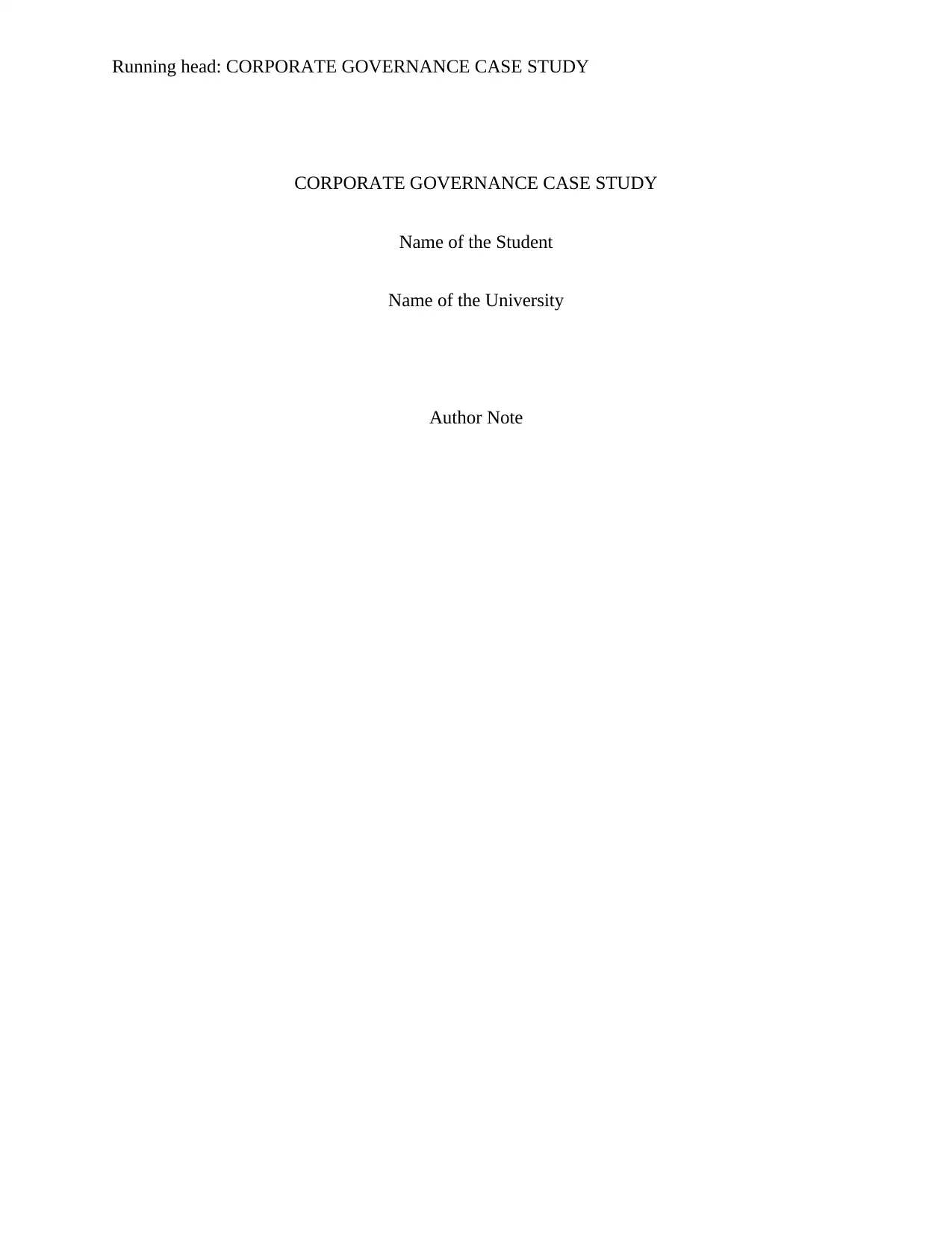
Running head: CORPORATE GOVERNANCE CASE STUDY
CORPORATE GOVERNANCE CASE STUDY
Name of the Student
Name of the University
Author Note
CORPORATE GOVERNANCE CASE STUDY
Name of the Student
Name of the University
Author Note
Paraphrase This Document
Need a fresh take? Get an instant paraphrase of this document with our AI Paraphraser
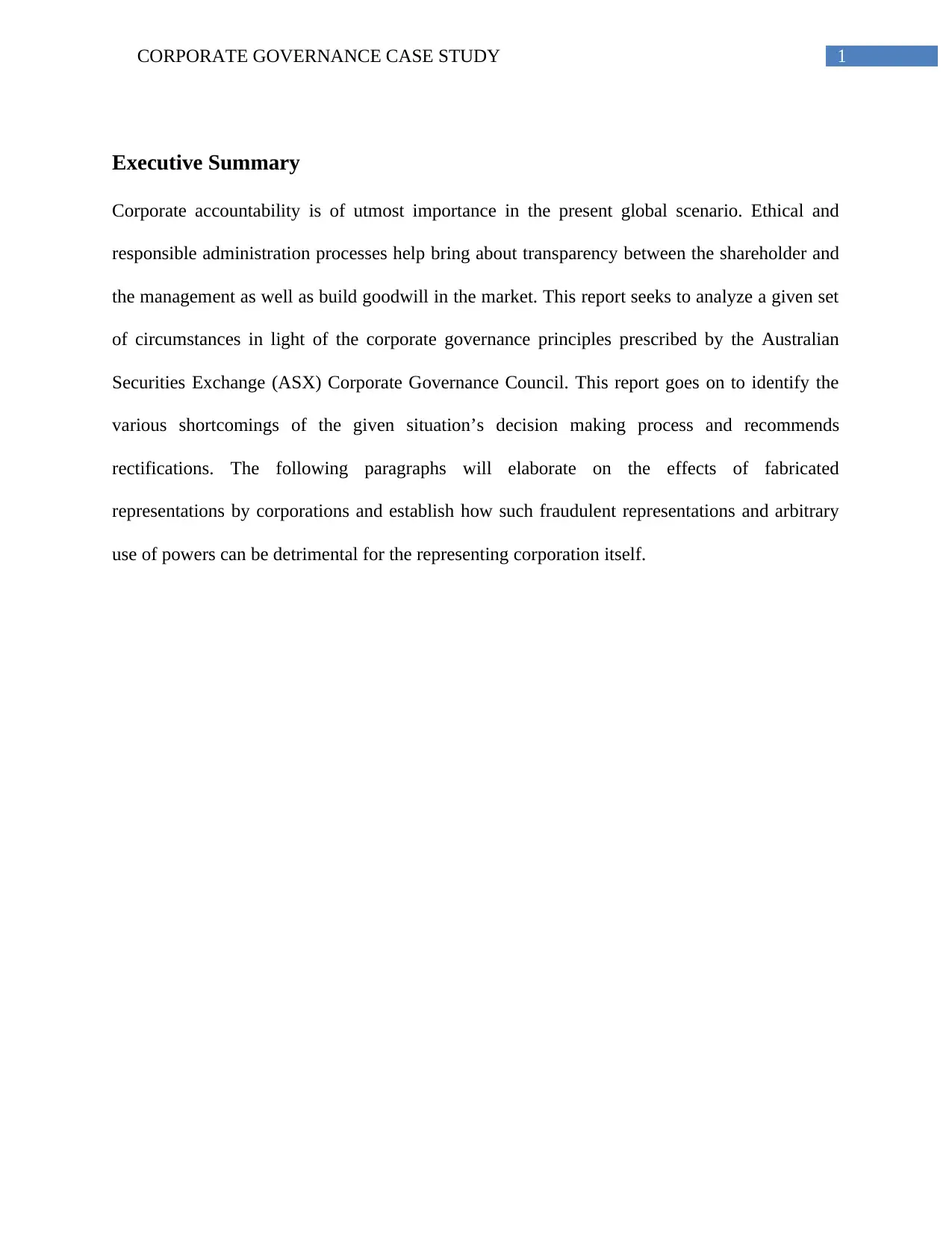
1CORPORATE GOVERNANCE CASE STUDY
Executive Summary
Corporate accountability is of utmost importance in the present global scenario. Ethical and
responsible administration processes help bring about transparency between the shareholder and
the management as well as build goodwill in the market. This report seeks to analyze a given set
of circumstances in light of the corporate governance principles prescribed by the Australian
Securities Exchange (ASX) Corporate Governance Council. This report goes on to identify the
various shortcomings of the given situation’s decision making process and recommends
rectifications. The following paragraphs will elaborate on the effects of fabricated
representations by corporations and establish how such fraudulent representations and arbitrary
use of powers can be detrimental for the representing corporation itself.
Executive Summary
Corporate accountability is of utmost importance in the present global scenario. Ethical and
responsible administration processes help bring about transparency between the shareholder and
the management as well as build goodwill in the market. This report seeks to analyze a given set
of circumstances in light of the corporate governance principles prescribed by the Australian
Securities Exchange (ASX) Corporate Governance Council. This report goes on to identify the
various shortcomings of the given situation’s decision making process and recommends
rectifications. The following paragraphs will elaborate on the effects of fabricated
representations by corporations and establish how such fraudulent representations and arbitrary
use of powers can be detrimental for the representing corporation itself.
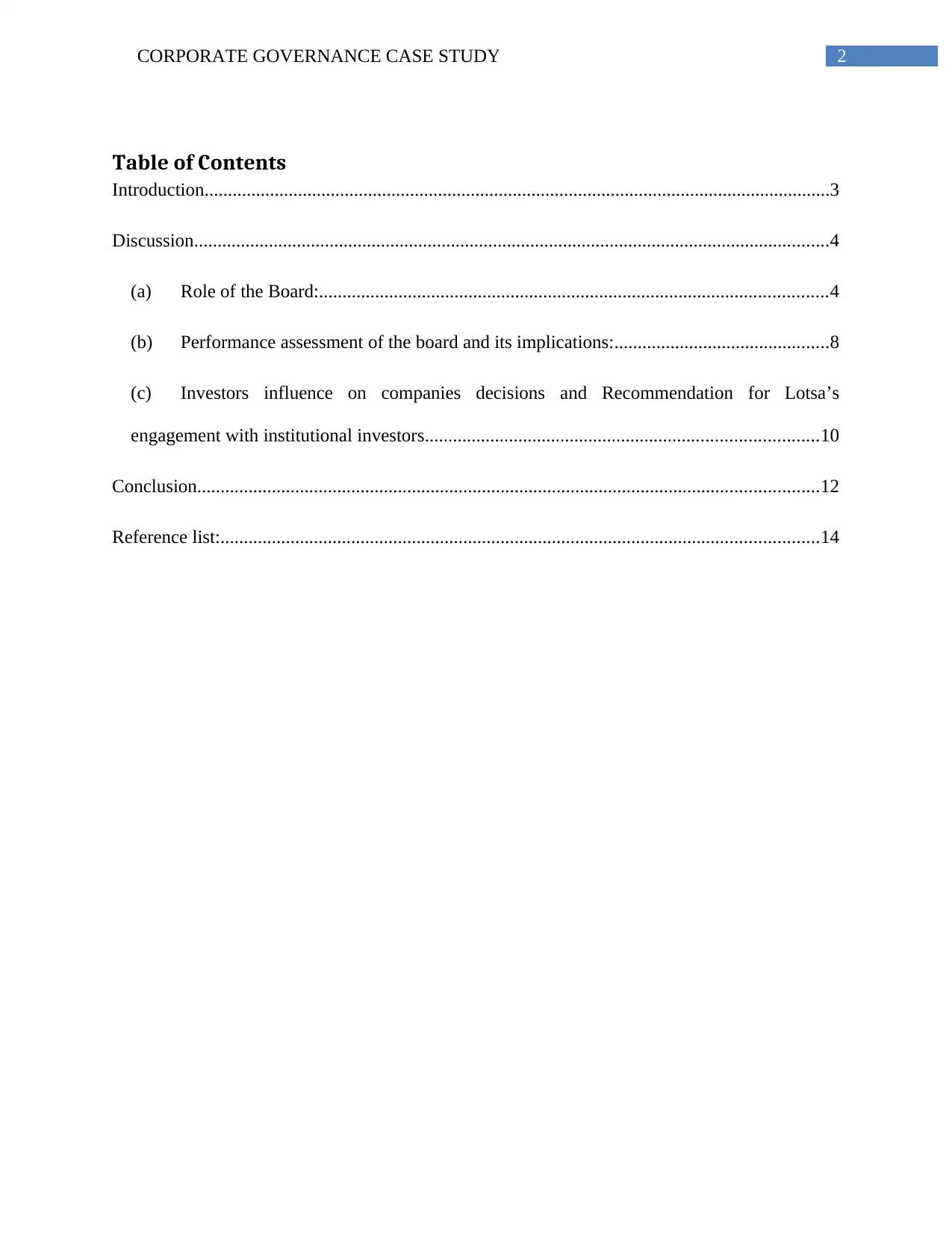
2CORPORATE GOVERNANCE CASE STUDY
Table of Contents
Introduction......................................................................................................................................3
Discussion........................................................................................................................................4
(a) Role of the Board:.............................................................................................................4
(b) Performance assessment of the board and its implications:..............................................8
(c) Investors influence on companies decisions and Recommendation for Lotsa’s
engagement with institutional investors....................................................................................10
Conclusion.....................................................................................................................................12
Reference list:................................................................................................................................14
Table of Contents
Introduction......................................................................................................................................3
Discussion........................................................................................................................................4
(a) Role of the Board:.............................................................................................................4
(b) Performance assessment of the board and its implications:..............................................8
(c) Investors influence on companies decisions and Recommendation for Lotsa’s
engagement with institutional investors....................................................................................10
Conclusion.....................................................................................................................................12
Reference list:................................................................................................................................14
⊘ This is a preview!⊘
Do you want full access?
Subscribe today to unlock all pages.

Trusted by 1+ million students worldwide
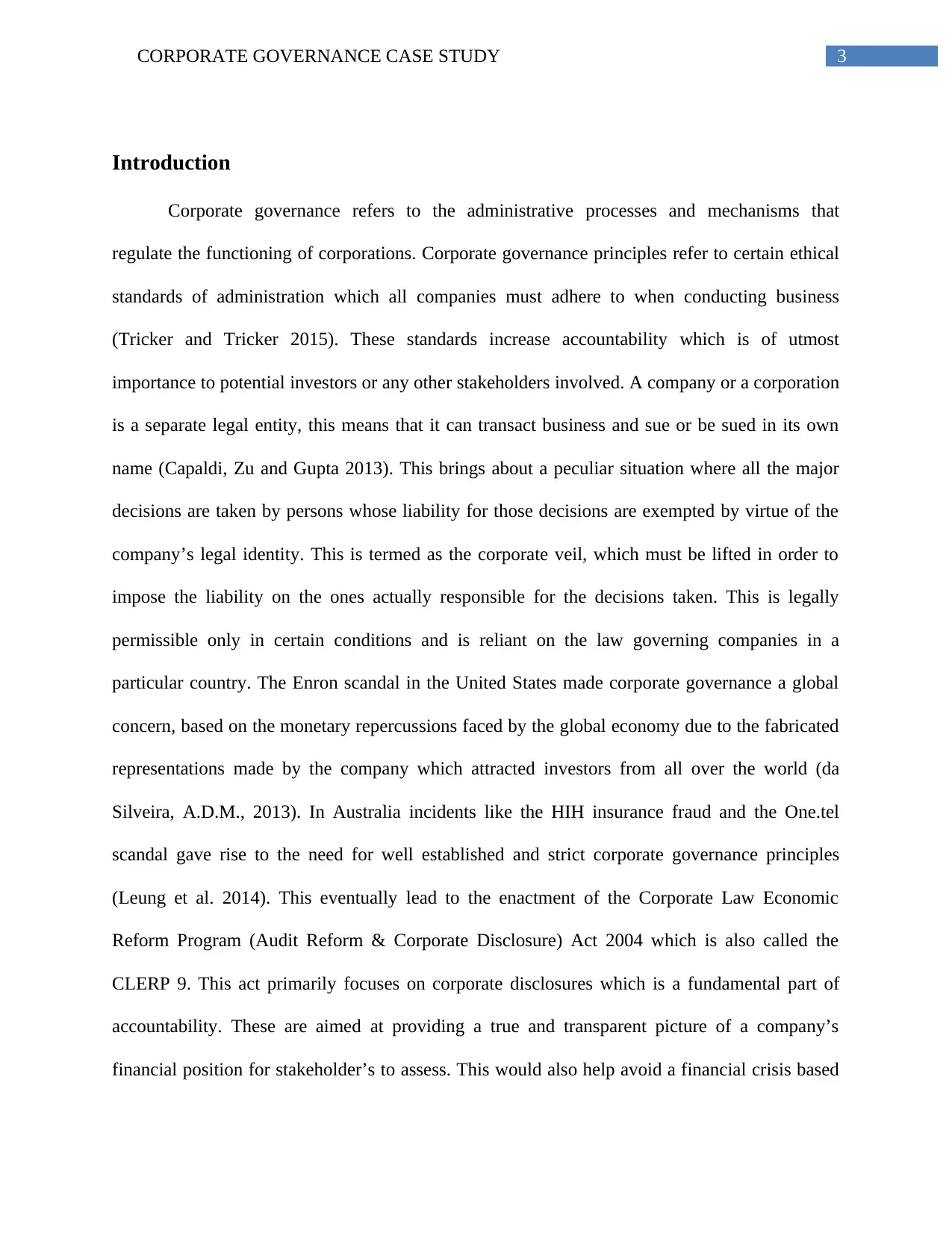
3CORPORATE GOVERNANCE CASE STUDY
Introduction
Corporate governance refers to the administrative processes and mechanisms that
regulate the functioning of corporations. Corporate governance principles refer to certain ethical
standards of administration which all companies must adhere to when conducting business
(Tricker and Tricker 2015). These standards increase accountability which is of utmost
importance to potential investors or any other stakeholders involved. A company or a corporation
is a separate legal entity, this means that it can transact business and sue or be sued in its own
name (Capaldi, Zu and Gupta 2013). This brings about a peculiar situation where all the major
decisions are taken by persons whose liability for those decisions are exempted by virtue of the
company’s legal identity. This is termed as the corporate veil, which must be lifted in order to
impose the liability on the ones actually responsible for the decisions taken. This is legally
permissible only in certain conditions and is reliant on the law governing companies in a
particular country. The Enron scandal in the United States made corporate governance a global
concern, based on the monetary repercussions faced by the global economy due to the fabricated
representations made by the company which attracted investors from all over the world (da
Silveira, A.D.M., 2013). In Australia incidents like the HIH insurance fraud and the One.tel
scandal gave rise to the need for well established and strict corporate governance principles
(Leung et al. 2014). This eventually lead to the enactment of the Corporate Law Economic
Reform Program (Audit Reform & Corporate Disclosure) Act 2004 which is also called the
CLERP 9. This act primarily focuses on corporate disclosures which is a fundamental part of
accountability. These are aimed at providing a true and transparent picture of a company’s
financial position for stakeholder’s to assess. This would also help avoid a financial crisis based
Introduction
Corporate governance refers to the administrative processes and mechanisms that
regulate the functioning of corporations. Corporate governance principles refer to certain ethical
standards of administration which all companies must adhere to when conducting business
(Tricker and Tricker 2015). These standards increase accountability which is of utmost
importance to potential investors or any other stakeholders involved. A company or a corporation
is a separate legal entity, this means that it can transact business and sue or be sued in its own
name (Capaldi, Zu and Gupta 2013). This brings about a peculiar situation where all the major
decisions are taken by persons whose liability for those decisions are exempted by virtue of the
company’s legal identity. This is termed as the corporate veil, which must be lifted in order to
impose the liability on the ones actually responsible for the decisions taken. This is legally
permissible only in certain conditions and is reliant on the law governing companies in a
particular country. The Enron scandal in the United States made corporate governance a global
concern, based on the monetary repercussions faced by the global economy due to the fabricated
representations made by the company which attracted investors from all over the world (da
Silveira, A.D.M., 2013). In Australia incidents like the HIH insurance fraud and the One.tel
scandal gave rise to the need for well established and strict corporate governance principles
(Leung et al. 2014). This eventually lead to the enactment of the Corporate Law Economic
Reform Program (Audit Reform & Corporate Disclosure) Act 2004 which is also called the
CLERP 9. This act primarily focuses on corporate disclosures which is a fundamental part of
accountability. These are aimed at providing a true and transparent picture of a company’s
financial position for stakeholder’s to assess. This would also help avoid a financial crisis based
Paraphrase This Document
Need a fresh take? Get an instant paraphrase of this document with our AI Paraphraser
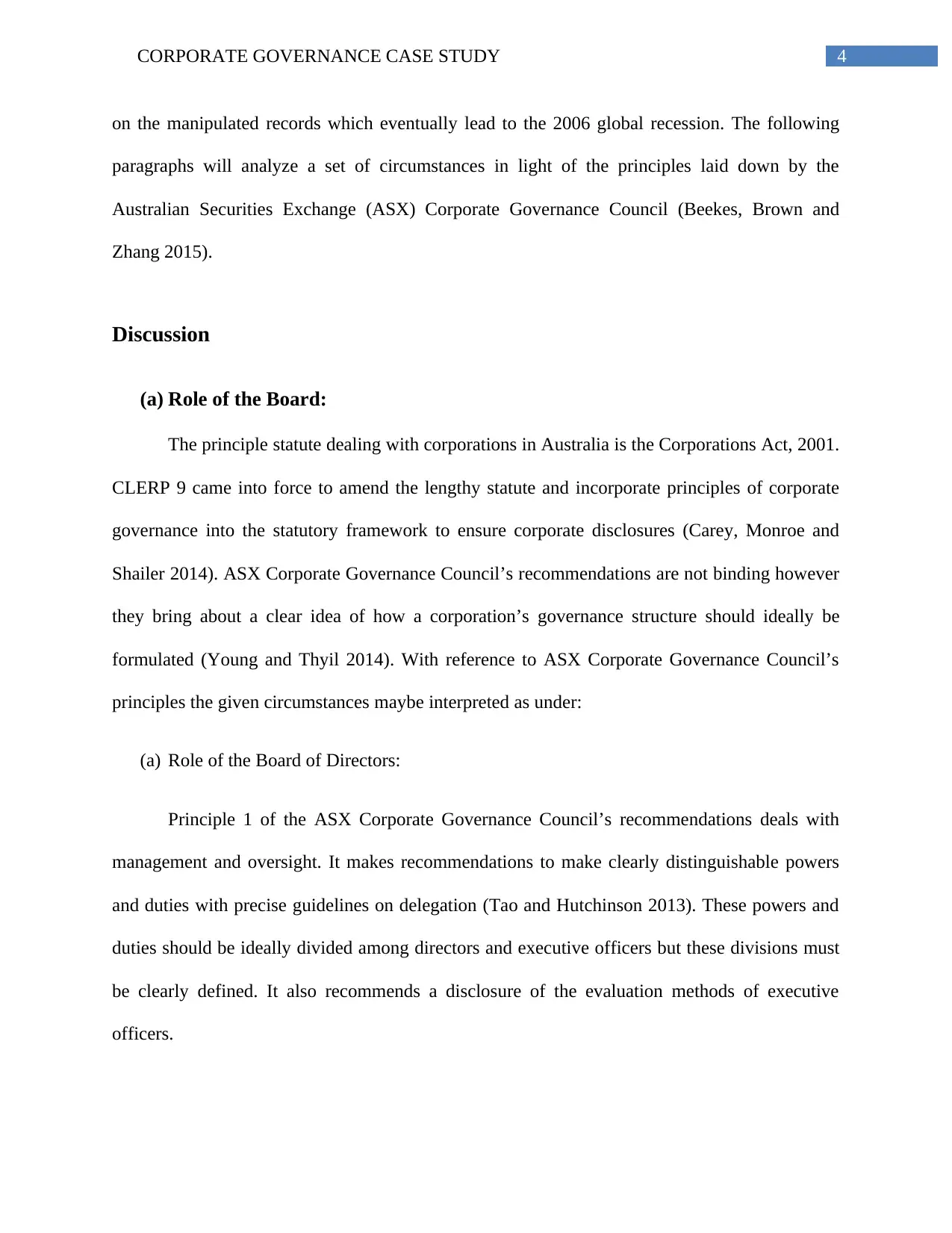
4CORPORATE GOVERNANCE CASE STUDY
on the manipulated records which eventually lead to the 2006 global recession. The following
paragraphs will analyze a set of circumstances in light of the principles laid down by the
Australian Securities Exchange (ASX) Corporate Governance Council (Beekes, Brown and
Zhang 2015).
Discussion
(a) Role of the Board:
The principle statute dealing with corporations in Australia is the Corporations Act, 2001.
CLERP 9 came into force to amend the lengthy statute and incorporate principles of corporate
governance into the statutory framework to ensure corporate disclosures (Carey, Monroe and
Shailer 2014). ASX Corporate Governance Council’s recommendations are not binding however
they bring about a clear idea of how a corporation’s governance structure should ideally be
formulated (Young and Thyil 2014). With reference to ASX Corporate Governance Council’s
principles the given circumstances maybe interpreted as under:
(a) Role of the Board of Directors:
Principle 1 of the ASX Corporate Governance Council’s recommendations deals with
management and oversight. It makes recommendations to make clearly distinguishable powers
and duties with precise guidelines on delegation (Tao and Hutchinson 2013). These powers and
duties should be ideally divided among directors and executive officers but these divisions must
be clearly defined. It also recommends a disclosure of the evaluation methods of executive
officers.
on the manipulated records which eventually lead to the 2006 global recession. The following
paragraphs will analyze a set of circumstances in light of the principles laid down by the
Australian Securities Exchange (ASX) Corporate Governance Council (Beekes, Brown and
Zhang 2015).
Discussion
(a) Role of the Board:
The principle statute dealing with corporations in Australia is the Corporations Act, 2001.
CLERP 9 came into force to amend the lengthy statute and incorporate principles of corporate
governance into the statutory framework to ensure corporate disclosures (Carey, Monroe and
Shailer 2014). ASX Corporate Governance Council’s recommendations are not binding however
they bring about a clear idea of how a corporation’s governance structure should ideally be
formulated (Young and Thyil 2014). With reference to ASX Corporate Governance Council’s
principles the given circumstances maybe interpreted as under:
(a) Role of the Board of Directors:
Principle 1 of the ASX Corporate Governance Council’s recommendations deals with
management and oversight. It makes recommendations to make clearly distinguishable powers
and duties with precise guidelines on delegation (Tao and Hutchinson 2013). These powers and
duties should be ideally divided among directors and executive officers but these divisions must
be clearly defined. It also recommends a disclosure of the evaluation methods of executive
officers.
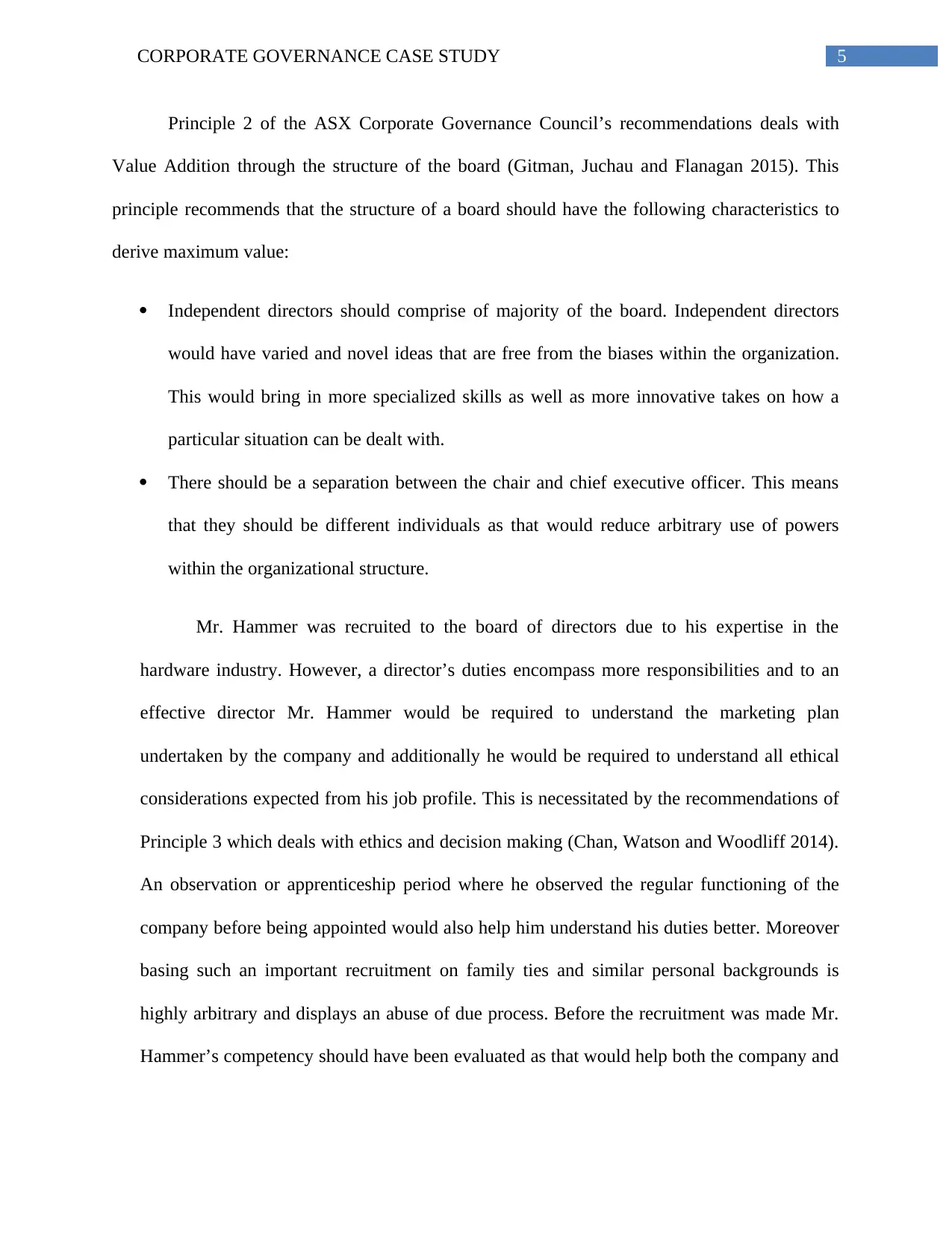
5CORPORATE GOVERNANCE CASE STUDY
Principle 2 of the ASX Corporate Governance Council’s recommendations deals with
Value Addition through the structure of the board (Gitman, Juchau and Flanagan 2015). This
principle recommends that the structure of a board should have the following characteristics to
derive maximum value:
Independent directors should comprise of majority of the board. Independent directors
would have varied and novel ideas that are free from the biases within the organization.
This would bring in more specialized skills as well as more innovative takes on how a
particular situation can be dealt with.
There should be a separation between the chair and chief executive officer. This means
that they should be different individuals as that would reduce arbitrary use of powers
within the organizational structure.
Mr. Hammer was recruited to the board of directors due to his expertise in the
hardware industry. However, a director’s duties encompass more responsibilities and to an
effective director Mr. Hammer would be required to understand the marketing plan
undertaken by the company and additionally he would be required to understand all ethical
considerations expected from his job profile. This is necessitated by the recommendations of
Principle 3 which deals with ethics and decision making (Chan, Watson and Woodliff 2014).
An observation or apprenticeship period where he observed the regular functioning of the
company before being appointed would also help him understand his duties better. Moreover
basing such an important recruitment on family ties and similar personal backgrounds is
highly arbitrary and displays an abuse of due process. Before the recruitment was made Mr.
Hammer’s competency should have been evaluated as that would help both the company and
Principle 2 of the ASX Corporate Governance Council’s recommendations deals with
Value Addition through the structure of the board (Gitman, Juchau and Flanagan 2015). This
principle recommends that the structure of a board should have the following characteristics to
derive maximum value:
Independent directors should comprise of majority of the board. Independent directors
would have varied and novel ideas that are free from the biases within the organization.
This would bring in more specialized skills as well as more innovative takes on how a
particular situation can be dealt with.
There should be a separation between the chair and chief executive officer. This means
that they should be different individuals as that would reduce arbitrary use of powers
within the organizational structure.
Mr. Hammer was recruited to the board of directors due to his expertise in the
hardware industry. However, a director’s duties encompass more responsibilities and to an
effective director Mr. Hammer would be required to understand the marketing plan
undertaken by the company and additionally he would be required to understand all ethical
considerations expected from his job profile. This is necessitated by the recommendations of
Principle 3 which deals with ethics and decision making (Chan, Watson and Woodliff 2014).
An observation or apprenticeship period where he observed the regular functioning of the
company before being appointed would also help him understand his duties better. Moreover
basing such an important recruitment on family ties and similar personal backgrounds is
highly arbitrary and displays an abuse of due process. Before the recruitment was made Mr.
Hammer’s competency should have been evaluated as that would help both the company and
⊘ This is a preview!⊘
Do you want full access?
Subscribe today to unlock all pages.

Trusted by 1+ million students worldwide
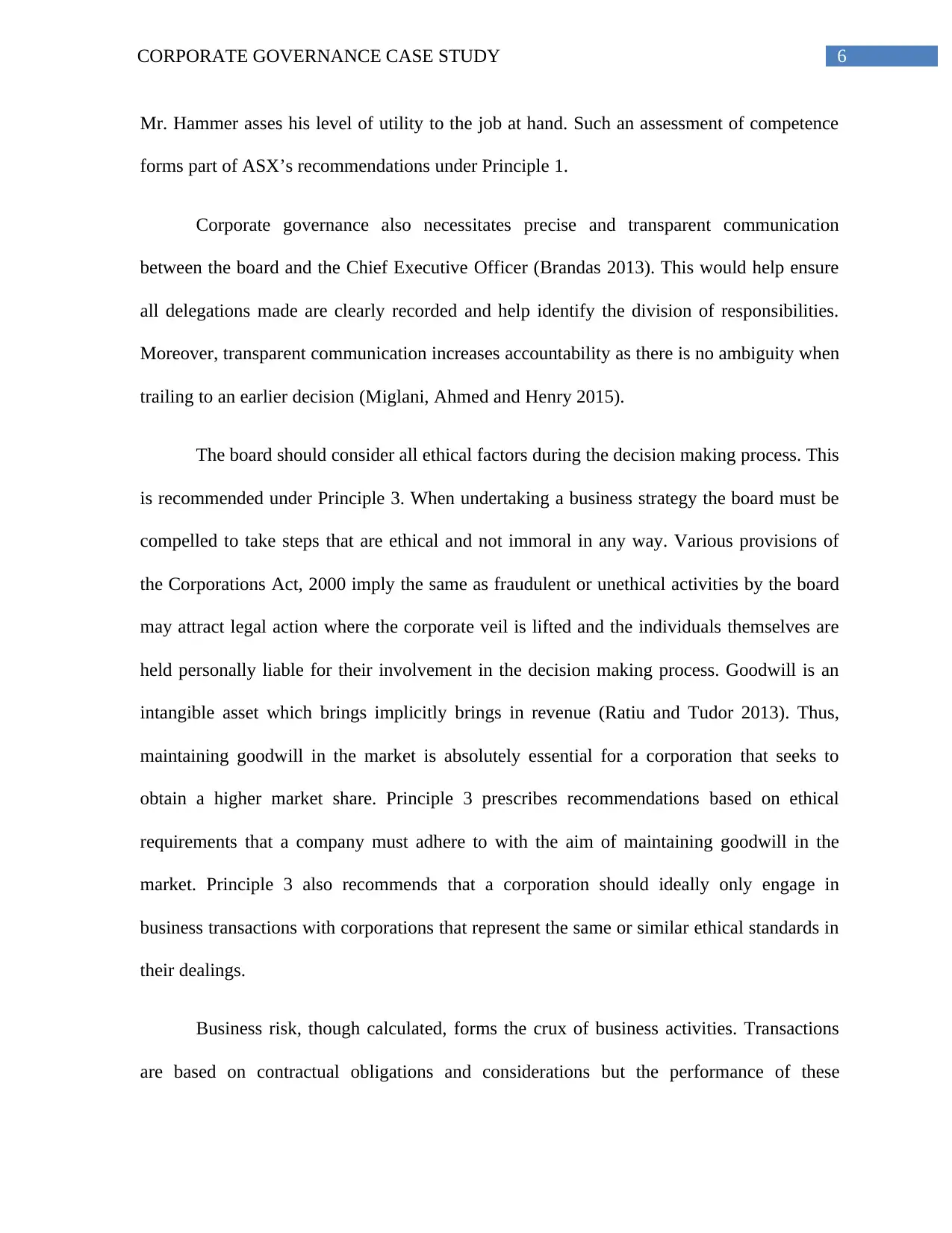
6CORPORATE GOVERNANCE CASE STUDY
Mr. Hammer asses his level of utility to the job at hand. Such an assessment of competence
forms part of ASX’s recommendations under Principle 1.
Corporate governance also necessitates precise and transparent communication
between the board and the Chief Executive Officer (Brandas 2013). This would help ensure
all delegations made are clearly recorded and help identify the division of responsibilities.
Moreover, transparent communication increases accountability as there is no ambiguity when
trailing to an earlier decision (Miglani, Ahmed and Henry 2015).
The board should consider all ethical factors during the decision making process. This
is recommended under Principle 3. When undertaking a business strategy the board must be
compelled to take steps that are ethical and not immoral in any way. Various provisions of
the Corporations Act, 2000 imply the same as fraudulent or unethical activities by the board
may attract legal action where the corporate veil is lifted and the individuals themselves are
held personally liable for their involvement in the decision making process. Goodwill is an
intangible asset which brings implicitly brings in revenue (Ratiu and Tudor 2013). Thus,
maintaining goodwill in the market is absolutely essential for a corporation that seeks to
obtain a higher market share. Principle 3 prescribes recommendations based on ethical
requirements that a company must adhere to with the aim of maintaining goodwill in the
market. Principle 3 also recommends that a corporation should ideally only engage in
business transactions with corporations that represent the same or similar ethical standards in
their dealings.
Business risk, though calculated, forms the crux of business activities. Transactions
are based on contractual obligations and considerations but the performance of these
Mr. Hammer asses his level of utility to the job at hand. Such an assessment of competence
forms part of ASX’s recommendations under Principle 1.
Corporate governance also necessitates precise and transparent communication
between the board and the Chief Executive Officer (Brandas 2013). This would help ensure
all delegations made are clearly recorded and help identify the division of responsibilities.
Moreover, transparent communication increases accountability as there is no ambiguity when
trailing to an earlier decision (Miglani, Ahmed and Henry 2015).
The board should consider all ethical factors during the decision making process. This
is recommended under Principle 3. When undertaking a business strategy the board must be
compelled to take steps that are ethical and not immoral in any way. Various provisions of
the Corporations Act, 2000 imply the same as fraudulent or unethical activities by the board
may attract legal action where the corporate veil is lifted and the individuals themselves are
held personally liable for their involvement in the decision making process. Goodwill is an
intangible asset which brings implicitly brings in revenue (Ratiu and Tudor 2013). Thus,
maintaining goodwill in the market is absolutely essential for a corporation that seeks to
obtain a higher market share. Principle 3 prescribes recommendations based on ethical
requirements that a company must adhere to with the aim of maintaining goodwill in the
market. Principle 3 also recommends that a corporation should ideally only engage in
business transactions with corporations that represent the same or similar ethical standards in
their dealings.
Business risk, though calculated, forms the crux of business activities. Transactions
are based on contractual obligations and considerations but the performance of these
Paraphrase This Document
Need a fresh take? Get an instant paraphrase of this document with our AI Paraphraser
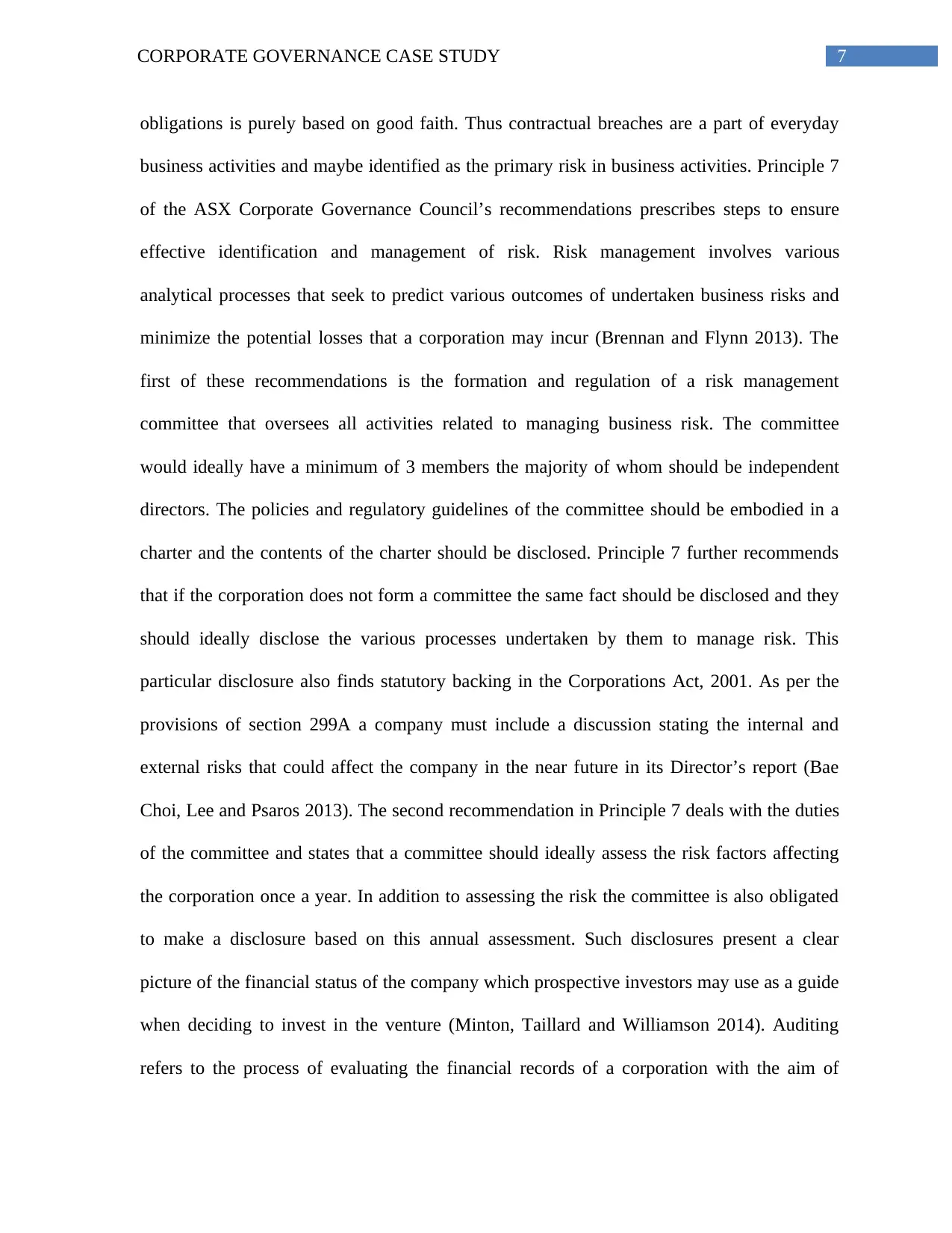
7CORPORATE GOVERNANCE CASE STUDY
obligations is purely based on good faith. Thus contractual breaches are a part of everyday
business activities and maybe identified as the primary risk in business activities. Principle 7
of the ASX Corporate Governance Council’s recommendations prescribes steps to ensure
effective identification and management of risk. Risk management involves various
analytical processes that seek to predict various outcomes of undertaken business risks and
minimize the potential losses that a corporation may incur (Brennan and Flynn 2013). The
first of these recommendations is the formation and regulation of a risk management
committee that oversees all activities related to managing business risk. The committee
would ideally have a minimum of 3 members the majority of whom should be independent
directors. The policies and regulatory guidelines of the committee should be embodied in a
charter and the contents of the charter should be disclosed. Principle 7 further recommends
that if the corporation does not form a committee the same fact should be disclosed and they
should ideally disclose the various processes undertaken by them to manage risk. This
particular disclosure also finds statutory backing in the Corporations Act, 2001. As per the
provisions of section 299A a company must include a discussion stating the internal and
external risks that could affect the company in the near future in its Director’s report (Bae
Choi, Lee and Psaros 2013). The second recommendation in Principle 7 deals with the duties
of the committee and states that a committee should ideally assess the risk factors affecting
the corporation once a year. In addition to assessing the risk the committee is also obligated
to make a disclosure based on this annual assessment. Such disclosures present a clear
picture of the financial status of the company which prospective investors may use as a guide
when deciding to invest in the venture (Minton, Taillard and Williamson 2014). Auditing
refers to the process of evaluating the financial records of a corporation with the aim of
obligations is purely based on good faith. Thus contractual breaches are a part of everyday
business activities and maybe identified as the primary risk in business activities. Principle 7
of the ASX Corporate Governance Council’s recommendations prescribes steps to ensure
effective identification and management of risk. Risk management involves various
analytical processes that seek to predict various outcomes of undertaken business risks and
minimize the potential losses that a corporation may incur (Brennan and Flynn 2013). The
first of these recommendations is the formation and regulation of a risk management
committee that oversees all activities related to managing business risk. The committee
would ideally have a minimum of 3 members the majority of whom should be independent
directors. The policies and regulatory guidelines of the committee should be embodied in a
charter and the contents of the charter should be disclosed. Principle 7 further recommends
that if the corporation does not form a committee the same fact should be disclosed and they
should ideally disclose the various processes undertaken by them to manage risk. This
particular disclosure also finds statutory backing in the Corporations Act, 2001. As per the
provisions of section 299A a company must include a discussion stating the internal and
external risks that could affect the company in the near future in its Director’s report (Bae
Choi, Lee and Psaros 2013). The second recommendation in Principle 7 deals with the duties
of the committee and states that a committee should ideally assess the risk factors affecting
the corporation once a year. In addition to assessing the risk the committee is also obligated
to make a disclosure based on this annual assessment. Such disclosures present a clear
picture of the financial status of the company which prospective investors may use as a guide
when deciding to invest in the venture (Minton, Taillard and Williamson 2014). Auditing
refers to the process of evaluating the financial records of a corporation with the aim of
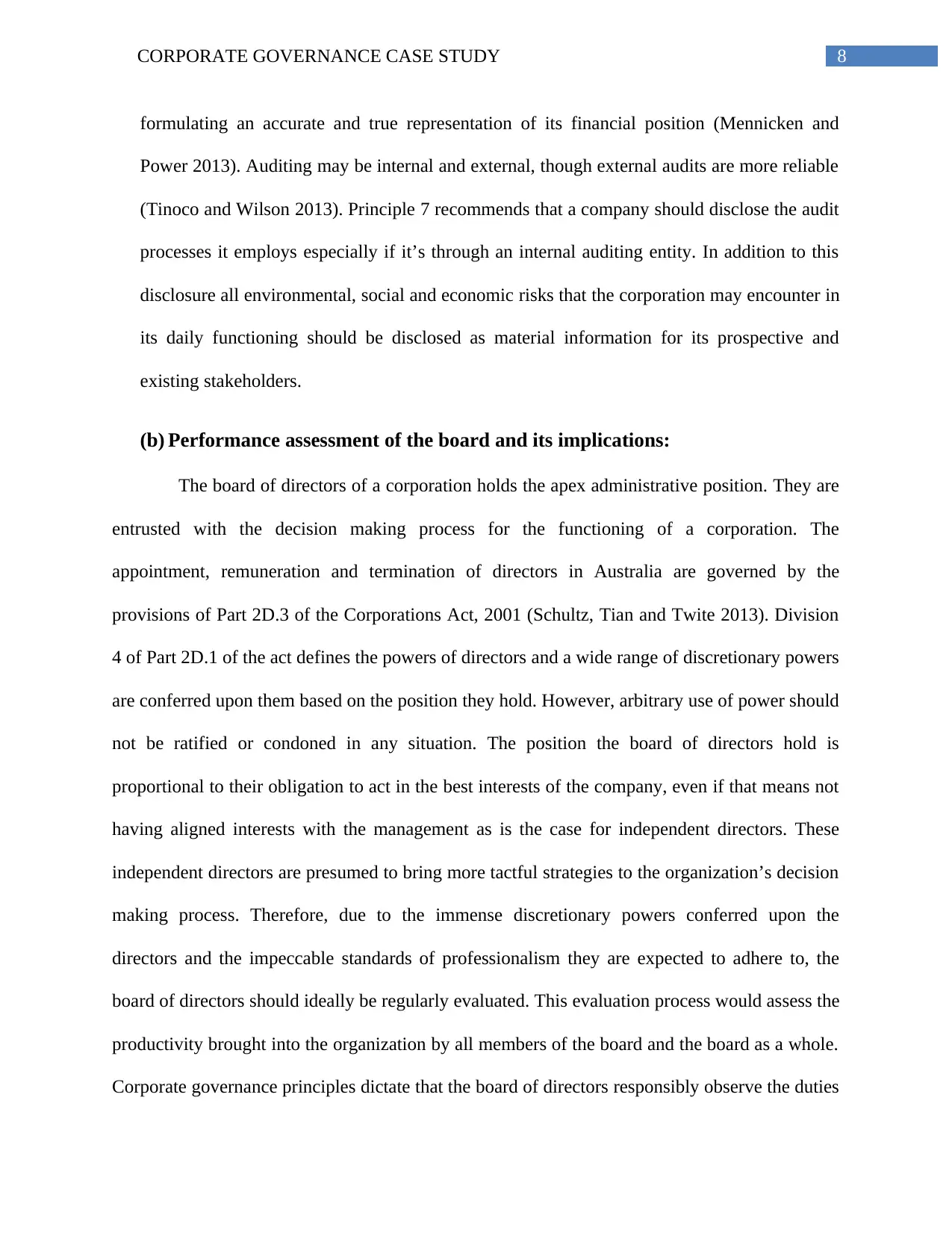
8CORPORATE GOVERNANCE CASE STUDY
formulating an accurate and true representation of its financial position (Mennicken and
Power 2013). Auditing may be internal and external, though external audits are more reliable
(Tinoco and Wilson 2013). Principle 7 recommends that a company should disclose the audit
processes it employs especially if it’s through an internal auditing entity. In addition to this
disclosure all environmental, social and economic risks that the corporation may encounter in
its daily functioning should be disclosed as material information for its prospective and
existing stakeholders.
(b) Performance assessment of the board and its implications:
The board of directors of a corporation holds the apex administrative position. They are
entrusted with the decision making process for the functioning of a corporation. The
appointment, remuneration and termination of directors in Australia are governed by the
provisions of Part 2D.3 of the Corporations Act, 2001 (Schultz, Tian and Twite 2013). Division
4 of Part 2D.1 of the act defines the powers of directors and a wide range of discretionary powers
are conferred upon them based on the position they hold. However, arbitrary use of power should
not be ratified or condoned in any situation. The position the board of directors hold is
proportional to their obligation to act in the best interests of the company, even if that means not
having aligned interests with the management as is the case for independent directors. These
independent directors are presumed to bring more tactful strategies to the organization’s decision
making process. Therefore, due to the immense discretionary powers conferred upon the
directors and the impeccable standards of professionalism they are expected to adhere to, the
board of directors should ideally be regularly evaluated. This evaluation process would assess the
productivity brought into the organization by all members of the board and the board as a whole.
Corporate governance principles dictate that the board of directors responsibly observe the duties
formulating an accurate and true representation of its financial position (Mennicken and
Power 2013). Auditing may be internal and external, though external audits are more reliable
(Tinoco and Wilson 2013). Principle 7 recommends that a company should disclose the audit
processes it employs especially if it’s through an internal auditing entity. In addition to this
disclosure all environmental, social and economic risks that the corporation may encounter in
its daily functioning should be disclosed as material information for its prospective and
existing stakeholders.
(b) Performance assessment of the board and its implications:
The board of directors of a corporation holds the apex administrative position. They are
entrusted with the decision making process for the functioning of a corporation. The
appointment, remuneration and termination of directors in Australia are governed by the
provisions of Part 2D.3 of the Corporations Act, 2001 (Schultz, Tian and Twite 2013). Division
4 of Part 2D.1 of the act defines the powers of directors and a wide range of discretionary powers
are conferred upon them based on the position they hold. However, arbitrary use of power should
not be ratified or condoned in any situation. The position the board of directors hold is
proportional to their obligation to act in the best interests of the company, even if that means not
having aligned interests with the management as is the case for independent directors. These
independent directors are presumed to bring more tactful strategies to the organization’s decision
making process. Therefore, due to the immense discretionary powers conferred upon the
directors and the impeccable standards of professionalism they are expected to adhere to, the
board of directors should ideally be regularly evaluated. This evaluation process would assess the
productivity brought into the organization by all members of the board and the board as a whole.
Corporate governance principles dictate that the board of directors responsibly observe the duties
⊘ This is a preview!⊘
Do you want full access?
Subscribe today to unlock all pages.

Trusted by 1+ million students worldwide
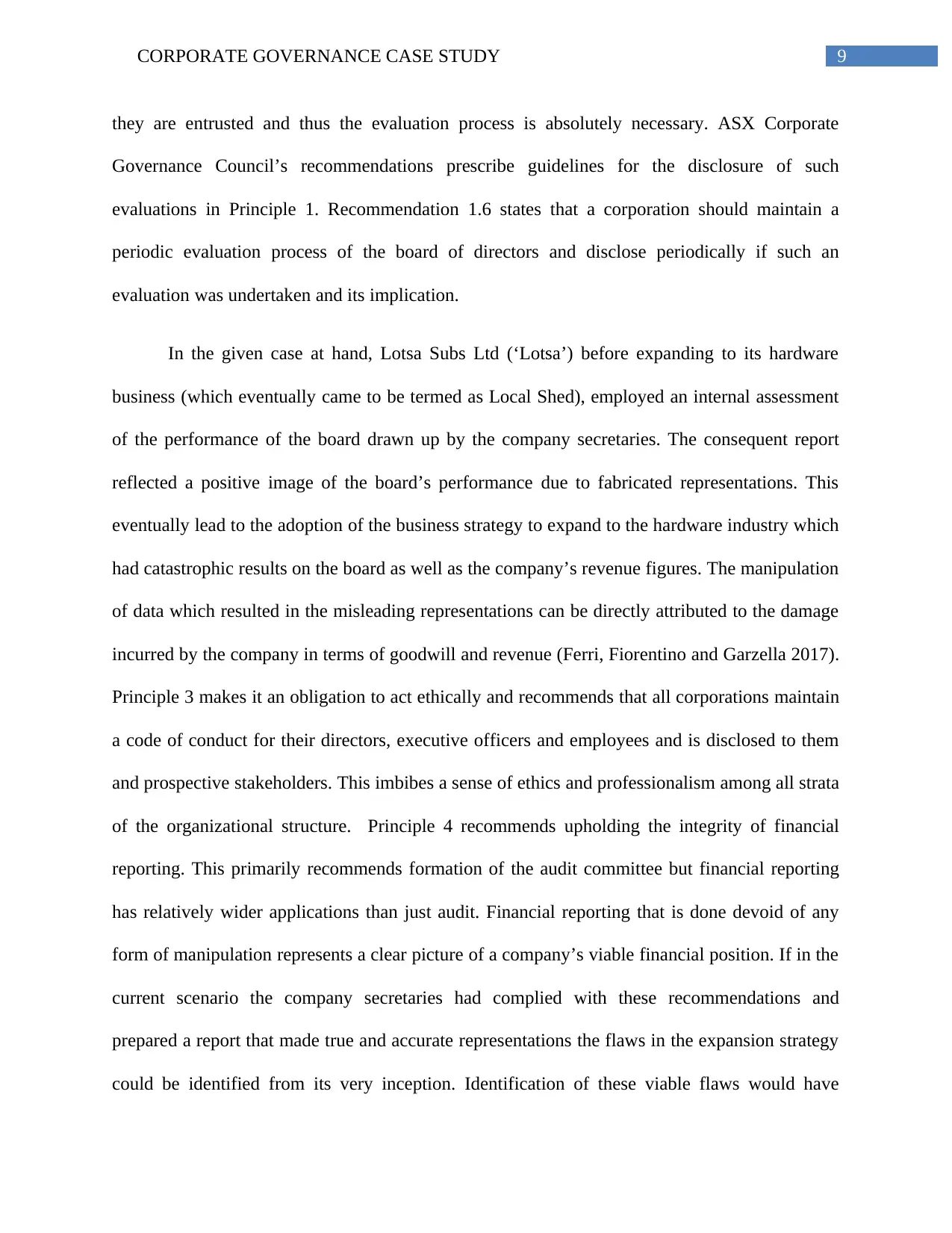
9CORPORATE GOVERNANCE CASE STUDY
they are entrusted and thus the evaluation process is absolutely necessary. ASX Corporate
Governance Council’s recommendations prescribe guidelines for the disclosure of such
evaluations in Principle 1. Recommendation 1.6 states that a corporation should maintain a
periodic evaluation process of the board of directors and disclose periodically if such an
evaluation was undertaken and its implication.
In the given case at hand, Lotsa Subs Ltd (‘Lotsa’) before expanding to its hardware
business (which eventually came to be termed as Local Shed), employed an internal assessment
of the performance of the board drawn up by the company secretaries. The consequent report
reflected a positive image of the board’s performance due to fabricated representations. This
eventually lead to the adoption of the business strategy to expand to the hardware industry which
had catastrophic results on the board as well as the company’s revenue figures. The manipulation
of data which resulted in the misleading representations can be directly attributed to the damage
incurred by the company in terms of goodwill and revenue (Ferri, Fiorentino and Garzella 2017).
Principle 3 makes it an obligation to act ethically and recommends that all corporations maintain
a code of conduct for their directors, executive officers and employees and is disclosed to them
and prospective stakeholders. This imbibes a sense of ethics and professionalism among all strata
of the organizational structure. Principle 4 recommends upholding the integrity of financial
reporting. This primarily recommends formation of the audit committee but financial reporting
has relatively wider applications than just audit. Financial reporting that is done devoid of any
form of manipulation represents a clear picture of a company’s viable financial position. If in the
current scenario the company secretaries had complied with these recommendations and
prepared a report that made true and accurate representations the flaws in the expansion strategy
could be identified from its very inception. Identification of these viable flaws would have
they are entrusted and thus the evaluation process is absolutely necessary. ASX Corporate
Governance Council’s recommendations prescribe guidelines for the disclosure of such
evaluations in Principle 1. Recommendation 1.6 states that a corporation should maintain a
periodic evaluation process of the board of directors and disclose periodically if such an
evaluation was undertaken and its implication.
In the given case at hand, Lotsa Subs Ltd (‘Lotsa’) before expanding to its hardware
business (which eventually came to be termed as Local Shed), employed an internal assessment
of the performance of the board drawn up by the company secretaries. The consequent report
reflected a positive image of the board’s performance due to fabricated representations. This
eventually lead to the adoption of the business strategy to expand to the hardware industry which
had catastrophic results on the board as well as the company’s revenue figures. The manipulation
of data which resulted in the misleading representations can be directly attributed to the damage
incurred by the company in terms of goodwill and revenue (Ferri, Fiorentino and Garzella 2017).
Principle 3 makes it an obligation to act ethically and recommends that all corporations maintain
a code of conduct for their directors, executive officers and employees and is disclosed to them
and prospective stakeholders. This imbibes a sense of ethics and professionalism among all strata
of the organizational structure. Principle 4 recommends upholding the integrity of financial
reporting. This primarily recommends formation of the audit committee but financial reporting
has relatively wider applications than just audit. Financial reporting that is done devoid of any
form of manipulation represents a clear picture of a company’s viable financial position. If in the
current scenario the company secretaries had complied with these recommendations and
prepared a report that made true and accurate representations the flaws in the expansion strategy
could be identified from its very inception. Identification of these viable flaws would have
Paraphrase This Document
Need a fresh take? Get an instant paraphrase of this document with our AI Paraphraser
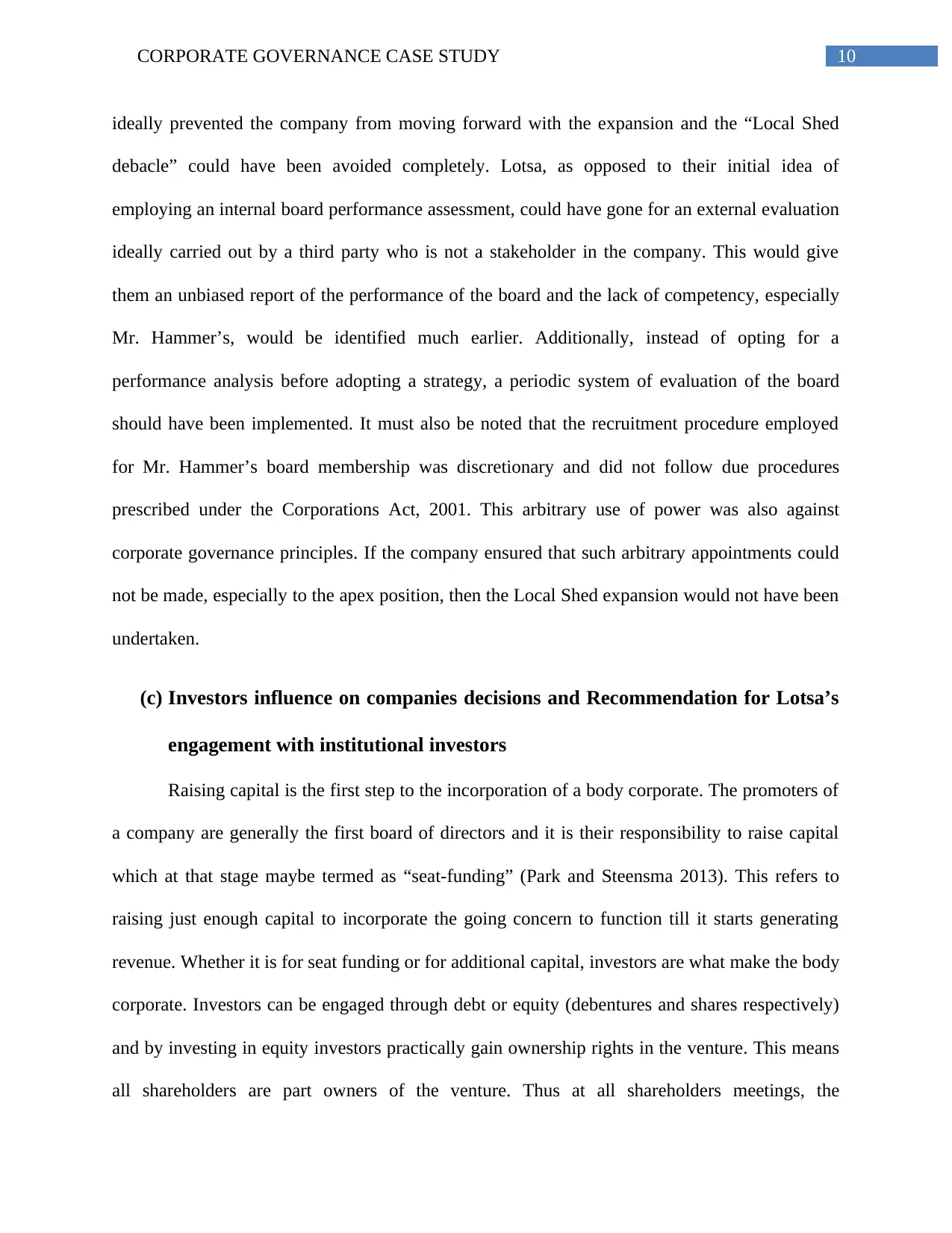
10CORPORATE GOVERNANCE CASE STUDY
ideally prevented the company from moving forward with the expansion and the “Local Shed
debacle” could have been avoided completely. Lotsa, as opposed to their initial idea of
employing an internal board performance assessment, could have gone for an external evaluation
ideally carried out by a third party who is not a stakeholder in the company. This would give
them an unbiased report of the performance of the board and the lack of competency, especially
Mr. Hammer’s, would be identified much earlier. Additionally, instead of opting for a
performance analysis before adopting a strategy, a periodic system of evaluation of the board
should have been implemented. It must also be noted that the recruitment procedure employed
for Mr. Hammer’s board membership was discretionary and did not follow due procedures
prescribed under the Corporations Act, 2001. This arbitrary use of power was also against
corporate governance principles. If the company ensured that such arbitrary appointments could
not be made, especially to the apex position, then the Local Shed expansion would not have been
undertaken.
(c) Investors influence on companies decisions and Recommendation for Lotsa’s
engagement with institutional investors
Raising capital is the first step to the incorporation of a body corporate. The promoters of
a company are generally the first board of directors and it is their responsibility to raise capital
which at that stage maybe termed as “seat-funding” (Park and Steensma 2013). This refers to
raising just enough capital to incorporate the going concern to function till it starts generating
revenue. Whether it is for seat funding or for additional capital, investors are what make the body
corporate. Investors can be engaged through debt or equity (debentures and shares respectively)
and by investing in equity investors practically gain ownership rights in the venture. This means
all shareholders are part owners of the venture. Thus at all shareholders meetings, the
ideally prevented the company from moving forward with the expansion and the “Local Shed
debacle” could have been avoided completely. Lotsa, as opposed to their initial idea of
employing an internal board performance assessment, could have gone for an external evaluation
ideally carried out by a third party who is not a stakeholder in the company. This would give
them an unbiased report of the performance of the board and the lack of competency, especially
Mr. Hammer’s, would be identified much earlier. Additionally, instead of opting for a
performance analysis before adopting a strategy, a periodic system of evaluation of the board
should have been implemented. It must also be noted that the recruitment procedure employed
for Mr. Hammer’s board membership was discretionary and did not follow due procedures
prescribed under the Corporations Act, 2001. This arbitrary use of power was also against
corporate governance principles. If the company ensured that such arbitrary appointments could
not be made, especially to the apex position, then the Local Shed expansion would not have been
undertaken.
(c) Investors influence on companies decisions and Recommendation for Lotsa’s
engagement with institutional investors
Raising capital is the first step to the incorporation of a body corporate. The promoters of
a company are generally the first board of directors and it is their responsibility to raise capital
which at that stage maybe termed as “seat-funding” (Park and Steensma 2013). This refers to
raising just enough capital to incorporate the going concern to function till it starts generating
revenue. Whether it is for seat funding or for additional capital, investors are what make the body
corporate. Investors can be engaged through debt or equity (debentures and shares respectively)
and by investing in equity investors practically gain ownership rights in the venture. This means
all shareholders are part owners of the venture. Thus at all shareholders meetings, the
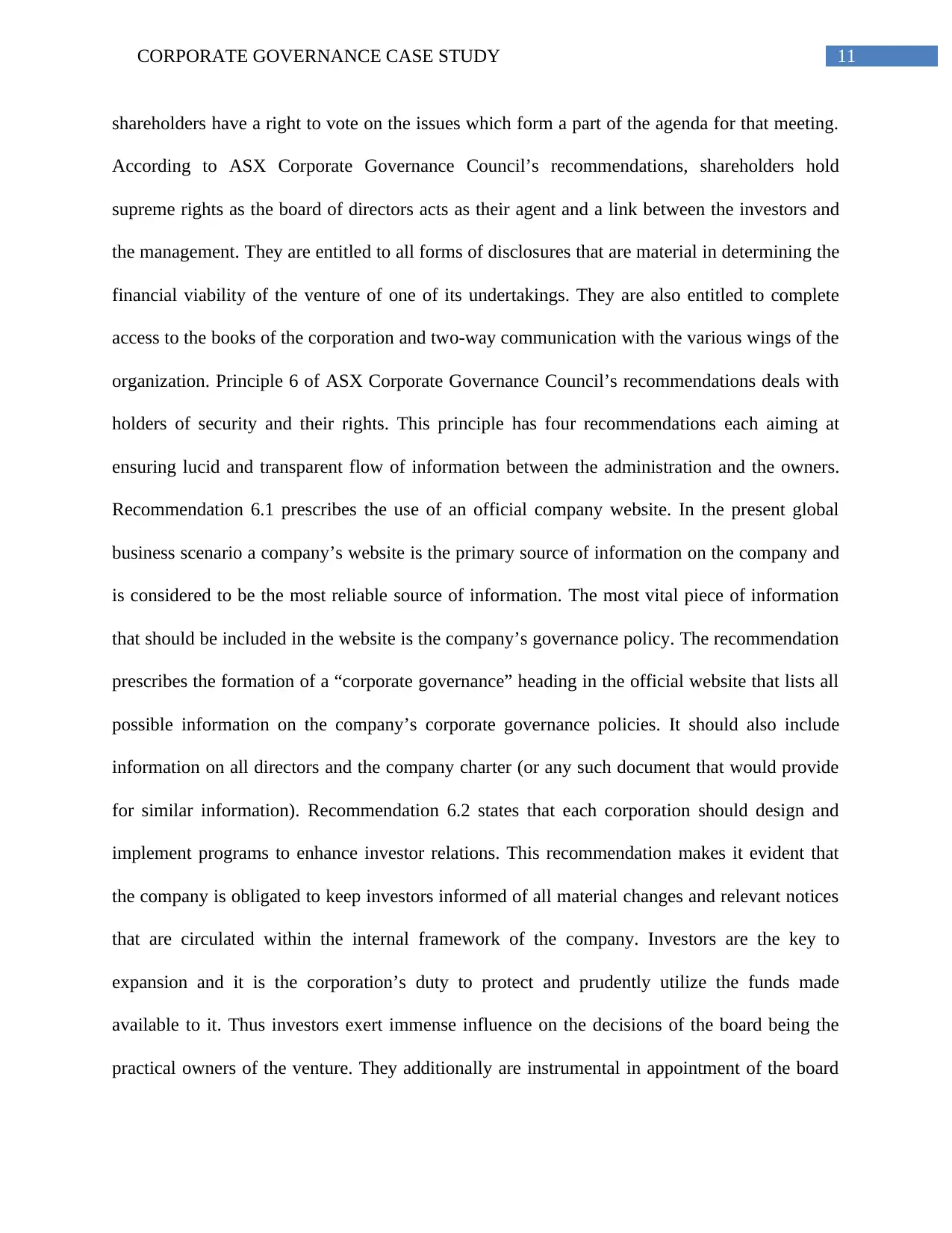
11CORPORATE GOVERNANCE CASE STUDY
shareholders have a right to vote on the issues which form a part of the agenda for that meeting.
According to ASX Corporate Governance Council’s recommendations, shareholders hold
supreme rights as the board of directors acts as their agent and a link between the investors and
the management. They are entitled to all forms of disclosures that are material in determining the
financial viability of the venture of one of its undertakings. They are also entitled to complete
access to the books of the corporation and two-way communication with the various wings of the
organization. Principle 6 of ASX Corporate Governance Council’s recommendations deals with
holders of security and their rights. This principle has four recommendations each aiming at
ensuring lucid and transparent flow of information between the administration and the owners.
Recommendation 6.1 prescribes the use of an official company website. In the present global
business scenario a company’s website is the primary source of information on the company and
is considered to be the most reliable source of information. The most vital piece of information
that should be included in the website is the company’s governance policy. The recommendation
prescribes the formation of a “corporate governance” heading in the official website that lists all
possible information on the company’s corporate governance policies. It should also include
information on all directors and the company charter (or any such document that would provide
for similar information). Recommendation 6.2 states that each corporation should design and
implement programs to enhance investor relations. This recommendation makes it evident that
the company is obligated to keep investors informed of all material changes and relevant notices
that are circulated within the internal framework of the company. Investors are the key to
expansion and it is the corporation’s duty to protect and prudently utilize the funds made
available to it. Thus investors exert immense influence on the decisions of the board being the
practical owners of the venture. They additionally are instrumental in appointment of the board
shareholders have a right to vote on the issues which form a part of the agenda for that meeting.
According to ASX Corporate Governance Council’s recommendations, shareholders hold
supreme rights as the board of directors acts as their agent and a link between the investors and
the management. They are entitled to all forms of disclosures that are material in determining the
financial viability of the venture of one of its undertakings. They are also entitled to complete
access to the books of the corporation and two-way communication with the various wings of the
organization. Principle 6 of ASX Corporate Governance Council’s recommendations deals with
holders of security and their rights. This principle has four recommendations each aiming at
ensuring lucid and transparent flow of information between the administration and the owners.
Recommendation 6.1 prescribes the use of an official company website. In the present global
business scenario a company’s website is the primary source of information on the company and
is considered to be the most reliable source of information. The most vital piece of information
that should be included in the website is the company’s governance policy. The recommendation
prescribes the formation of a “corporate governance” heading in the official website that lists all
possible information on the company’s corporate governance policies. It should also include
information on all directors and the company charter (or any such document that would provide
for similar information). Recommendation 6.2 states that each corporation should design and
implement programs to enhance investor relations. This recommendation makes it evident that
the company is obligated to keep investors informed of all material changes and relevant notices
that are circulated within the internal framework of the company. Investors are the key to
expansion and it is the corporation’s duty to protect and prudently utilize the funds made
available to it. Thus investors exert immense influence on the decisions of the board being the
practical owners of the venture. They additionally are instrumental in appointment of the board
⊘ This is a preview!⊘
Do you want full access?
Subscribe today to unlock all pages.

Trusted by 1+ million students worldwide
1 out of 17
Related Documents
Your All-in-One AI-Powered Toolkit for Academic Success.
+13062052269
info@desklib.com
Available 24*7 on WhatsApp / Email
![[object Object]](/_next/static/media/star-bottom.7253800d.svg)
Unlock your academic potential
Copyright © 2020–2025 A2Z Services. All Rights Reserved. Developed and managed by ZUCOL.





